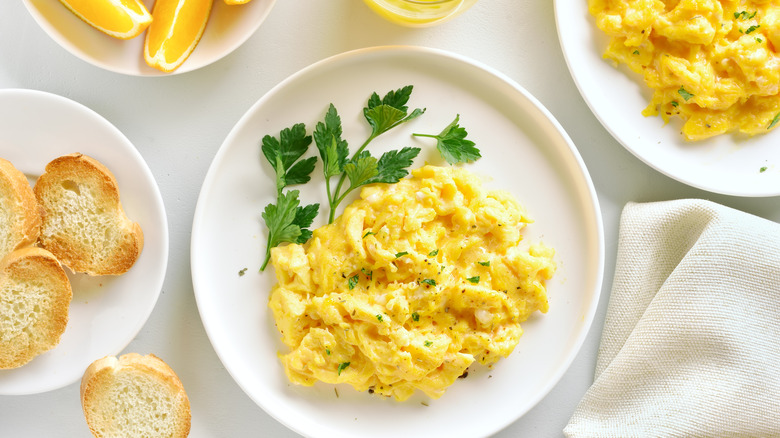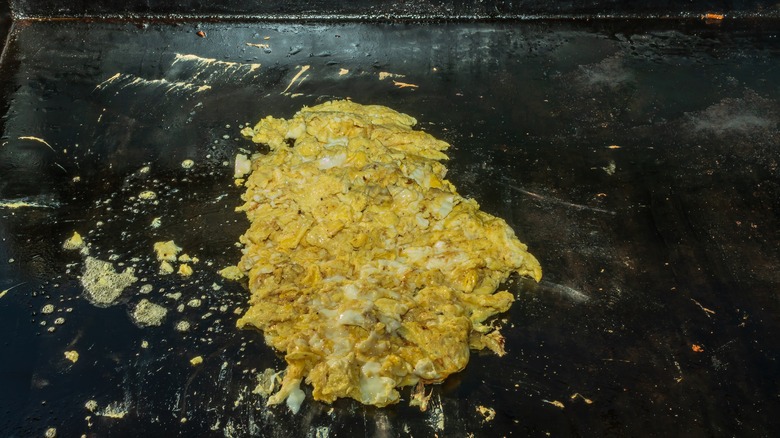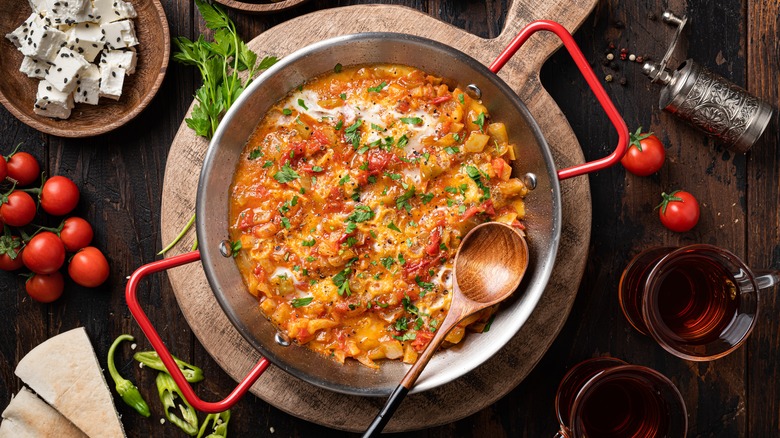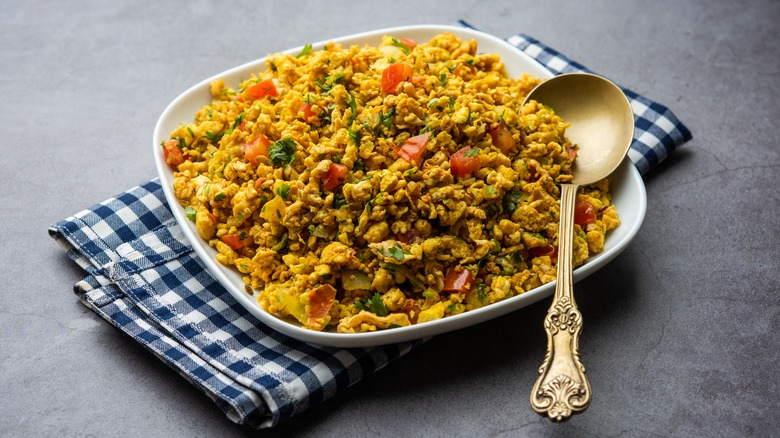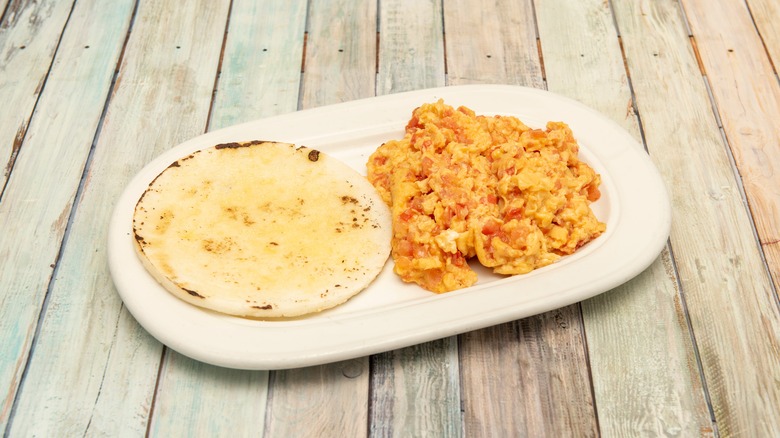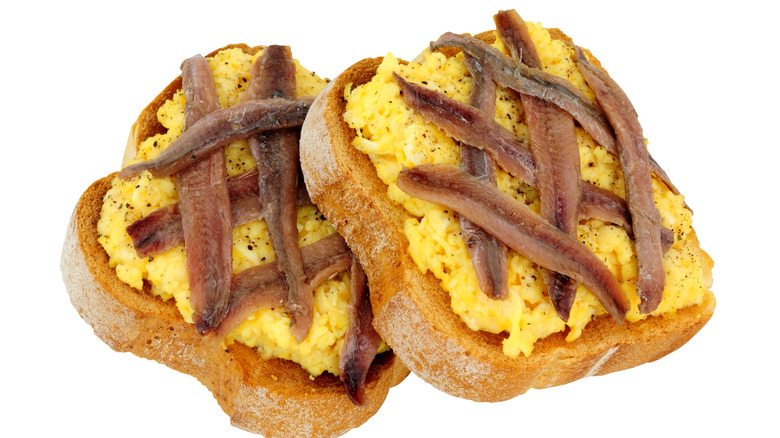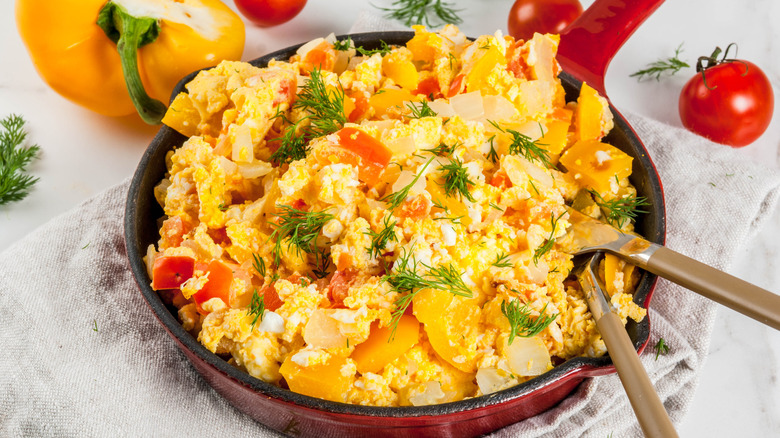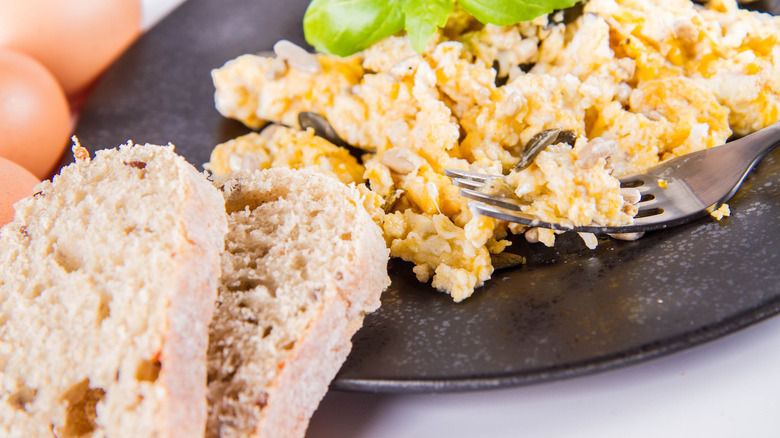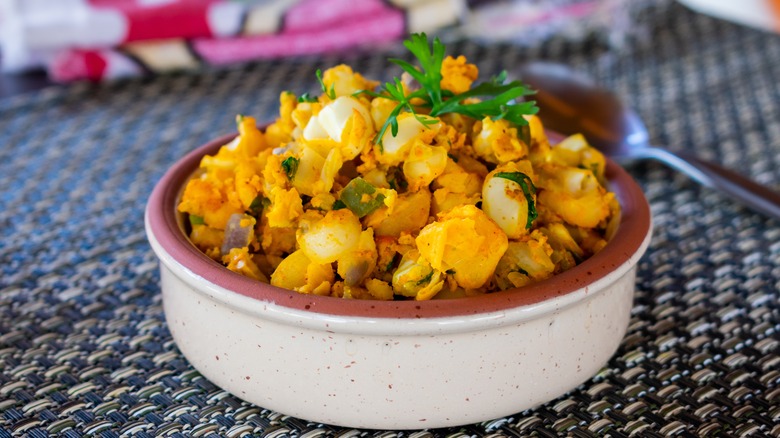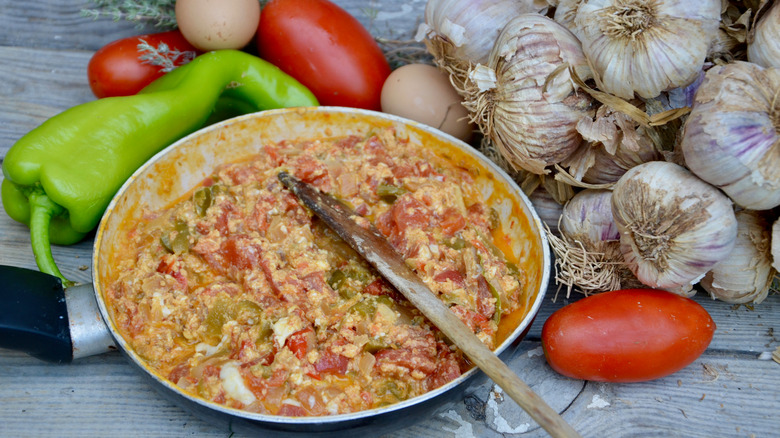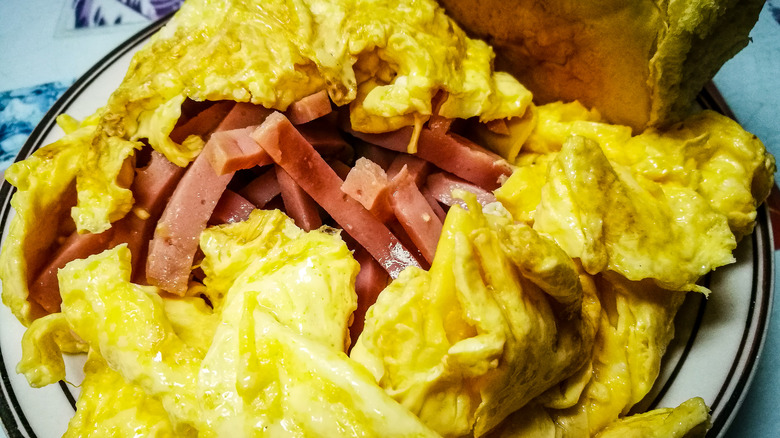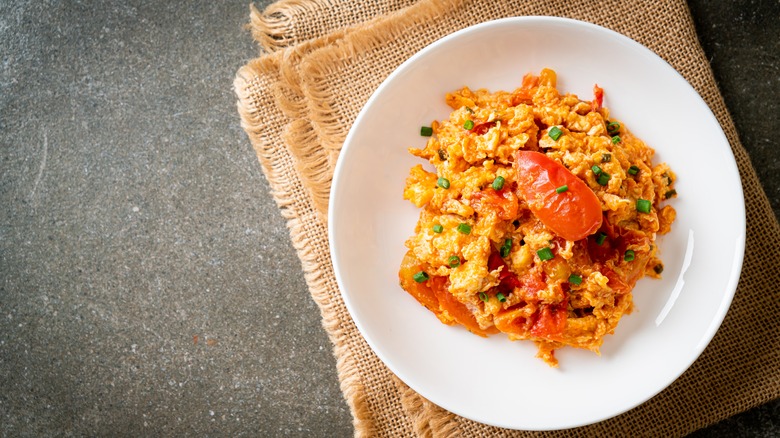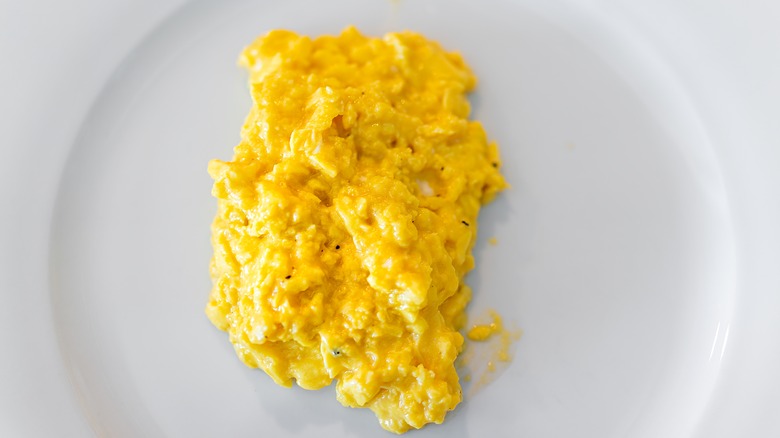How Scrambled Eggs Are Different Around The World
There's no wrong way to eat eggs — fried, poached, or baked into a frittata. But the most popular way to eat eggs is the classic scramble. This method of making eggs involves whipping fresh eggs in a bowl to infuse air and your desired seasonings into the mixture. Then the eggs are cooked until solidified and served hot. Easy, right?
Wrong. The perfect scrambled eggs are actually deceptively complex to make. Once you master the basic recipe for scrambled eggs with a few simple tricks, you can consult variations on scrambled eggs from across the globe. Different cuisines and countries have adapted scrambled eggs to suit regional variations in cooking methods as well as the availability of ingredients in other parts of the world. And once you try a scrambled egg recipe with the infusion of vegetables or unique regional seasoning, we doubt you will ever go back to ordering the same boring diner-style scrambled eggs ever again.
American hard-scrambled eggs
"American" style scrambled egg fits into the category of "hard" scrambled eggs. Hard-scrambled eggs are cooked over medium heat for longer than soft-scrambled eggs. Unlike other types of scrambled eggs, these are cooked all the way through and have an indistinguishable yolk-and-white line. These eggs flake much easier than soft-scrambled eggs, so you will likely notice translucent egg pieces left in the pan or on your plate after you finish making hard scrambled eggs. If the eggs are left in the pan after cooking, rather than removed immediately from the heat, you'll find brown spots on your eggs as well.
Hard scrambled eggs pair well with almost any other American breakfast and brunch food — including buttered toast, bacon, or sausage. Americans, who are as dairy-infatuated as possible, tend to add shredded cheddar cheese to the eggs as well for flavor and a bit of creaminess in the eggs.
Turkish menemen
Turkish menemen is the result of a myriad of flavors from the countries surrounding Turkey, including the Balkans, Caucasus, and Mediterranean regions. Menemen integrates the flavors of scrambled eggs along with peppers, tomatoes, and onion. The ingredients in menemen have a stark resemblance to Israeli shakshuka — a dish that poaches the eggs in the tomatoes and juices from the vegetables surrounding it. But menemen is different because it is made of whipped eggs rather than poached eggs. Menemen also does not contain harissa paste or the cinnamon traditionally found in shakshuka. Instead, menemen uses hot paprika and oregano for spicing with the help of optional ingredients like spiced sausage, cured beef, and lamb.
Menemen is traditionally eaten for breakfast in Turkey and obtained its name from the Turkish town of Menemen in Izmir on the Aegean coast (via The Mediterranean Dish). The Munchery notes that shakshuka and menemen likely soared in popularity because the recipes used up the surplus of tomatoes growing in the region during the summer.
Indian egg bhurji
Scroll.in notes that there are variations in bhurji across the Indian subcontinent. Eggs bhurji, which is also known as anda bhurji, is a scrambled egg dish made with flavorful spices like cumin, chili pepper, garam masala, turmeric, ginger, and coriander leaves. Some recipes add bell peppers and onions to the dish, but many variations just stick to eggs and a ton of savory spices. After the eggs are done cooking, the dish is usually served with a garnish of coriander leaves and a side of pav (bread roll), rice, or chapati.
Slurrp notes that eggs bhurji may have evolved from the ancient Roman preparation of eggs, with the inclusion of the spices endemic to the Indian subcontinent. While there are some parallels to Parisi Akuri, Slurrp notes that bhurji does not contain potatoes, ginger, and more mild spices. Eggs bhurji are also cooked longer than Akuri and do not have a soft, pourable consistency compared to the dryness of bhurji.
Columbian and Venezulan perico
Perico is a scrambled egg dish popular in Venezuela and Columbia, according to Taste Atlas. The basic recipe for perico includes scrambled eggs, onion, tomato, and butter. Columbian perico includes scallions, while Venezuelan versions of perico use coriander, annatto, and ground peppers. The key to making perico is to cook the eggs over low heat to maintain moisture and continuously mix them to prevent inconsistent heating on the eggs. The butter, an invaluable part of making soft scrambled eggs, is important in crafting a perfect perico flavor and preventing the eggs from sticking to the pan (via WiseGeek).
WiseGeek notes that perico is served with different sides depending on the region. In Columbia, perico is eaten for breakfast with meats like bacon, and Venezuelan perico is served with arepas, a muffin-like bread. Perico is popular for breakfast because it includes protein and vegetables, and it can also be made into a sandwich with two arepas and served for lunch or dinner.
Scotch woodcock
If you don't like anchovies, you might want to skip over this preparation of scrambled eggs. Per blogger Nick Young, Scotch woodcock is a Victorian-era dish that was often eaten as the savory accompaniment to the end of a meal. The New York Times notes that the origin of the name "Scotch woodcock" is not clearly known. The anchovies are used as a flavoring for the butter, which is spread on toast. The key to infusing the flavor, Young notes, is to use a mortar and pestle to blend the juices from the anchovies into the butter. The eggs are cooked separately in a pan with a bit of cream for softness before being added for a thin layer on top of the toast. Then, the anchovies are split in half and latticed on top of the bread and eggs. Some recipes do not lattice the anchovies and only include a single piece of anchovy — which might be a good option for people who are a bit squeamish about the fish.
Australian folded eggs
Australians blur the line between country and continent, so it's reasonable to know that they blur the line between an omelet and scrambled eggs with Australian folded eggs. This dish involves folding eggs into a small, circular omelet with characteristic ruffles that resemble a rose. The New York Times notes that Australian folded eggs are usually served with avocado for a boost of fat and vegetables.
Folded eggs are sturdier than scrambled eggs (since it's all in one piece), but not as much as a classic American omelet. The essential part about making folded eggs is to move quickly and keep the pan super hot. Many recipes mix eggs and heavy cream to preserve the soft consistency of the egg during cooking. Swirling the egg in the pan adds the rose-shaped design to the egg while allowing other parts to cook just enough. After the egg is finished cooking (but still soft), it is placed on top of a large piece of toast.
Huevos a la Mexicana
Huevos a la Mexicana is not to be confused with the other popular Mexican egg dish huevos rancheros. Huevos rancheros are made with poached eggs in a similar cooking method to shakshuka, in which the eggs are cooked in the residual liquid of the tomatoes (via El Meson). Huevos a la Mexicana scrambles the eggs with a mix of flavorful Mexican ingredients like green chili, peppers, red tomatoes, and white onions. Maricruz Valos notes Huevos a la Mexicana (Eggs of Mexico) gets its name from the bright colors in the dish that resemble the white, red, and green colors of the Mexican flag.
Huevos a la Mexicana is served for breakfast with a side of refried beans, salsa, tortillas, and coffee. Some variations on the recipe integrate flavors and seasonings, but the standard mix of vegetables and eggs remains the same. Huevos a la Mexicana can also be used as a filling for breakfast burritos and breakfast tacos.
Austrian eierspeise
Austrian eierspeise (also known as Styrian scrambled eggs) is a scrambled egg dish that uses a unique ingredient — pumpkin seeds. These eggs are cooked with shallots, ham, and toasted pumpkin seeds, as well as garnished with pumpkin seed oil, cheese, and sour cream. According to Saveur, pumpkin seed oil plays a pivotal role in the flavor of this egg dish. The fattiness of the pumpkin seed oil, along with its robustness and nutty flavor, maximize the flavor of the eierspeise without making it too heavy.
Austria has capitalized on growing oilseed pumpkins. These gourds are well-suited to the growing region of Styria — the southeast portion of the country. Pumpkin seed oil from the Gleisdorfer Olkurbis, an oilseed pumpkin developed in 1947, has since been called the "green gold" of the region. Styrians also use pumpkin seed oil (and the whole seeds) for dishes including crusted Styrian Fried Chicken and as a brittle recipe for a sweet after-dinner treat.
Ecuadorian mote pillo
Mote pillo is a scrambled egg dish from Ecuador. An important ingredient in this egg dish that separates it from other regional specialties is hominy. Hominy is a derivative of flint corn that is cooked like grits. In America, hominy is sold in cans with liquid or as a dried good. Ecuador Travel notes mote (hominy in Ecuador) is an indigenous staple that was first cooked in pottery, firewood, and ash to soften it before it was added to foods like mote pillo. Mote pillo is mixed with eggs, chopped green onion, lard, salt, milk, and cheese. The key to mote pillo, as the World Food Guide noted, is to keep the hominy as moist as possible.
Mote pillo is usually accompanied by coffee and queso fresco (via Visit Ecuador and South America). According to the World Food Guide, the Cuenca region in a southern Ecuador province claims root to this dish, most often eaten as a breakfast or a side dish.
Basque eggs pipérade
Eggs pipérade is a veggie-forward egg dish endemic to the Basque region of Spain. The eggs are spiced with a blend of bell peppers, onions, tomatoes, and bell peppers, onions, tomatoes, and a spice called piment d'Espelette. Piment d'Espelette is produced in the Basque region and has a bit more heat than paprika or cayenne pepper, per Culinary Ambition. The addition of this spice steps eggs pipérade up from its French cousin ratatouille — another stewed pepper, onion, and tomato dish.
Eggs pipérade can be made similar to a shakshuka, where the eggs are poached in the stewed vegetables or scrambled. The vegetables can also be sautéed to remove some of the moisture for a drier dish. When eggs pipérade are scrambled rather than poached, the eggs are typically added in at the end of cooking to avoid staining the eggs with the tomato juices.
Cantonese-style scrambled eggs
Cantonese-style scrambled eggs include several ingredients often found in Asian cooking — like monosodium glutamate (MSG), Shaoxing wine, toasted sesame oil, and lard. These ingredients utilize umami, salty, sweet, and sour flavors. To preserve the fluffy texture of the eggs during cooking, the whites and the yolks are separated, and the egg whites are beaten slightly until the yolks can be mixed. To keep the eggs as soft as possible, the eggs are cooked over high heat for a short time and scooped on top of others methodically.
Cantonese-style eggs are served wet — but still cooked through. This egg preparation can also be garnished with proteins like shrimp or pork. Redditors have customized Cantonese-style scrambled eggs by serving the eggs with white rice, cooked tomatoes, or steamed pork cake. Some Redditors have gone rogue and added lobster meat, chorizo, or cheddar cheese to the eggs for a Western influence.
Chinese scrambled egg with tomato
When you think of "Chinese food," your first inclination is probably not tomatoes. According to Silk Road Gourmet, "tomato eggs" can be dry or in a tomato broth and served over white rice or noodles. The basic ingredients for this dish include eggs, chopped green onions, Shaoxing wine, garlic, rice vinegar, and occasionally oyster sauce in addition to tomatoes.
Per The China Project, tomato egg stir fry (also known as xīhóngshì chǎo jīdàn) is consumed in Chinese homes and casual dining settings alike. The dish is a derivative of Shandong cuisine, one of China's eight regional cuisine types. According to an article published by Emory University, tomatoes arrived in Chinese cooking around the 1500s, where the fruit was first labeled as a "foreign eggplant." With time, tomatoes became adopted in some dishes, including scrambled eggs. People in China have eaten scrambled eggs for over 200 years, so a mix between the two seemed inevitable. Tomato scrambled eggs became even more popular in the 1940s with the start of the second World War when the dish became more of a home staple for Chinese families.
French soft-scrambled eggs
The French have been known to upgrade dishes with the addition of milk and cream. Can the same be said about scrambled eggs?
The main difference between French and American scrambled eggs is not the ingredients in the eggs (although we should note that the French are fond of a lot of butter in scrambled eggs) but the time it takes to cook the eggs. French scrambled eggs are cooked over low heat for upwards of 10 minutes. This low-and-slow method of cooking the eggs retains the moisture in the eggs and prevents crispy bits from appearing on the egg as it cooks. Although the egg cooks over low heat, this does not mean the egg can be ignored on the stove; it must be scrambled and moved around in the pan to ensure the entire egg is cooked. The creaminess of the egg lends itself well to spreading on top of toast or eating with other popular sides — if you can stand to wait for your egg to finish cooking. But after all, some of the best things in life just take time.
